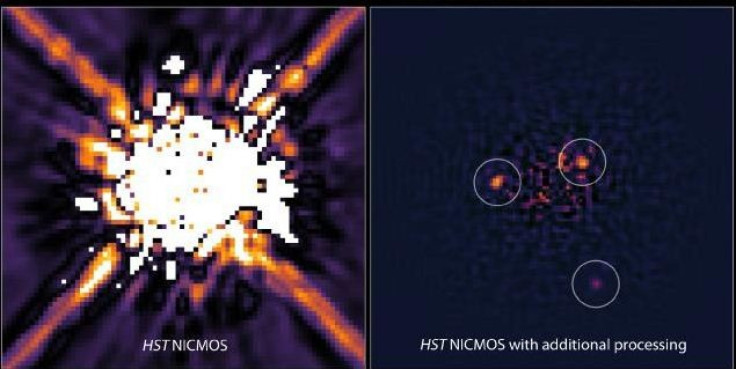New Evidence of Exoplanets garnered from Old Hubble Data: NASA

Scientists discovered visual evidence for two extrasolar planets from a decade-old images from NASA's Hubble Space Telescope, using new techniques comparable to a time machine.
A new analysis of the images taken in 1998 by Hubble's Near Infrared Camera and Multi-Oblect Spectrometer, or NICMOS, shed light on the previously undetected exoplanets orbiting HR 8799, a Sun-like star lying 130 light years away in the constellation Pegasus. While the imaging software available back then did not discover any planet, three planets were spotted in 2007 and 2008, and the fourth innermost planet in 2010.
In 2009, the same NICMOS data, with the help of a new technique, helped David Lafreniere of the University of Montreal recover hidden exoplanet data.
A new analysis of the same data was conducted by Remi Soummer of the Space Telescope Science Institute in Baltimore, who successfully recovered all three of the outer planets.
In recovering the hidden exoplanets, Lafreniere used a library of reference stars so the fingerprint glow of the central star can be removed more precisely. Further developing his method, Soummer's team used 466 images of reference stars from a library that has more than 10 years of NICMOS observations, and increased contrast and minimized residual starlight. The diffraction spikes, or artifacts common to telescope imaging systems, were also removed, allowing the researchers to spot two inner planets in the Hubble data - about 1/100,000th the brightness of the parent star in near-infrared light.
From the Hubble images, we can determine the shape of their orbits, which brings insight into the system stability, planet masses and eccentricities, and also the inclination of the system, said Soummer.
The three outer gas-giant planets orbit the central star taking approximately 100-, 200-, and 400-years each.
The extra time span added by the decade-old Hubble data helps see the slow paths of the planets.
The archive got us 10 years of science right now, says Soummer. Without this data we would have had to wait another decade. It's 10 years of science for free.
Hubble data archive stores images and spectral information from more than 20 years of the telescope's observation.
While the extra-slow outermost planet has barely changed position in 10 years, if we go to the next inner planet we see a little bit of an orbit, and the third inner planet we actually see a lot of motion, Soummer said.
The time machine-like data from the invaluable past can generate more future discoveries than new observations alone, according to NASA.
What's really exciting now is that we're going to apply the same method to a bunch of other stars, and hopefully we'll make some discoveries of our own, said Brendan Hagan from Goucher College in Baltimore, reports MSNBC.
The findings will be published in the Astrophysical Journal.
© Copyright IBTimes 2024. All rights reserved.











